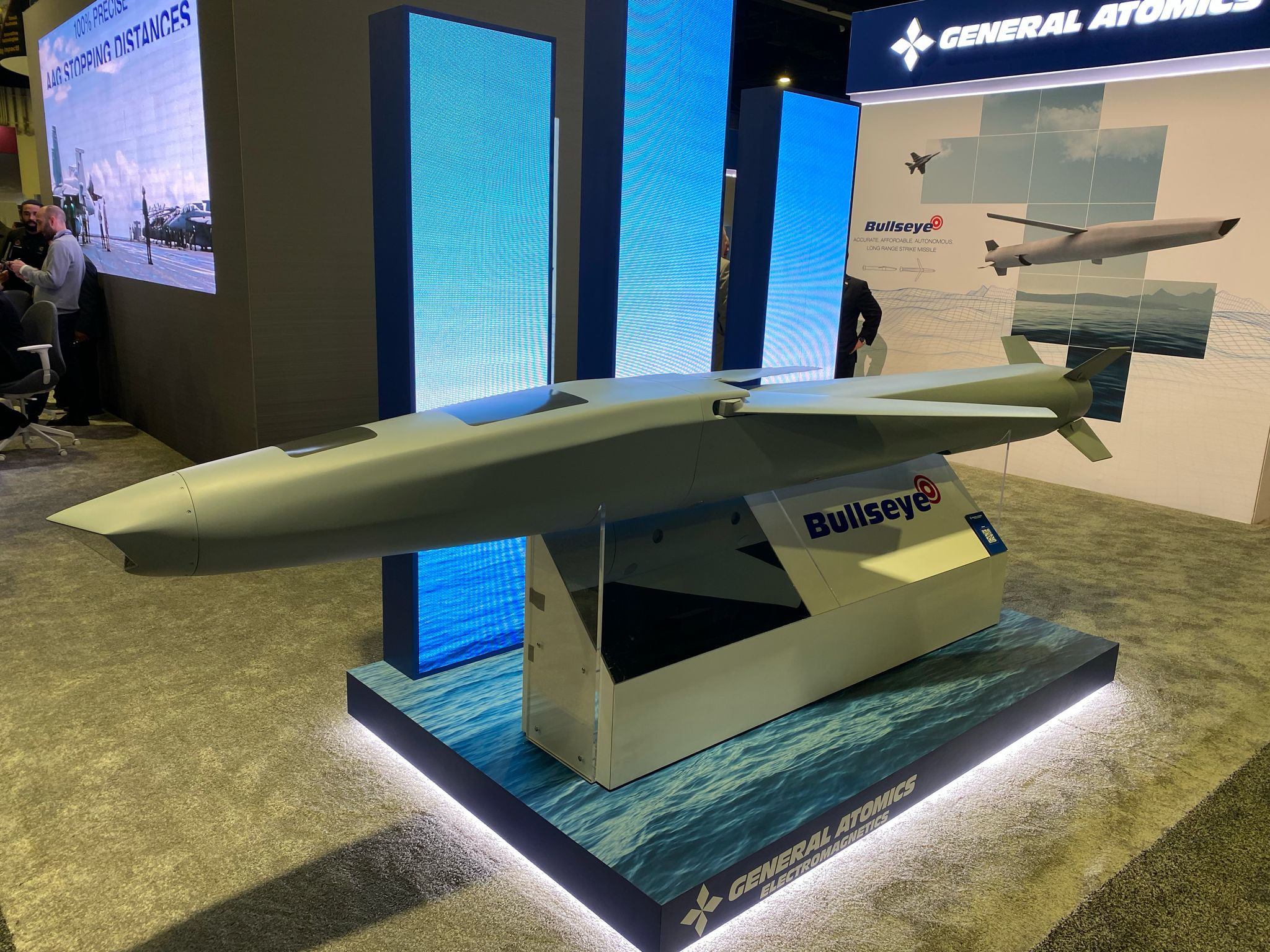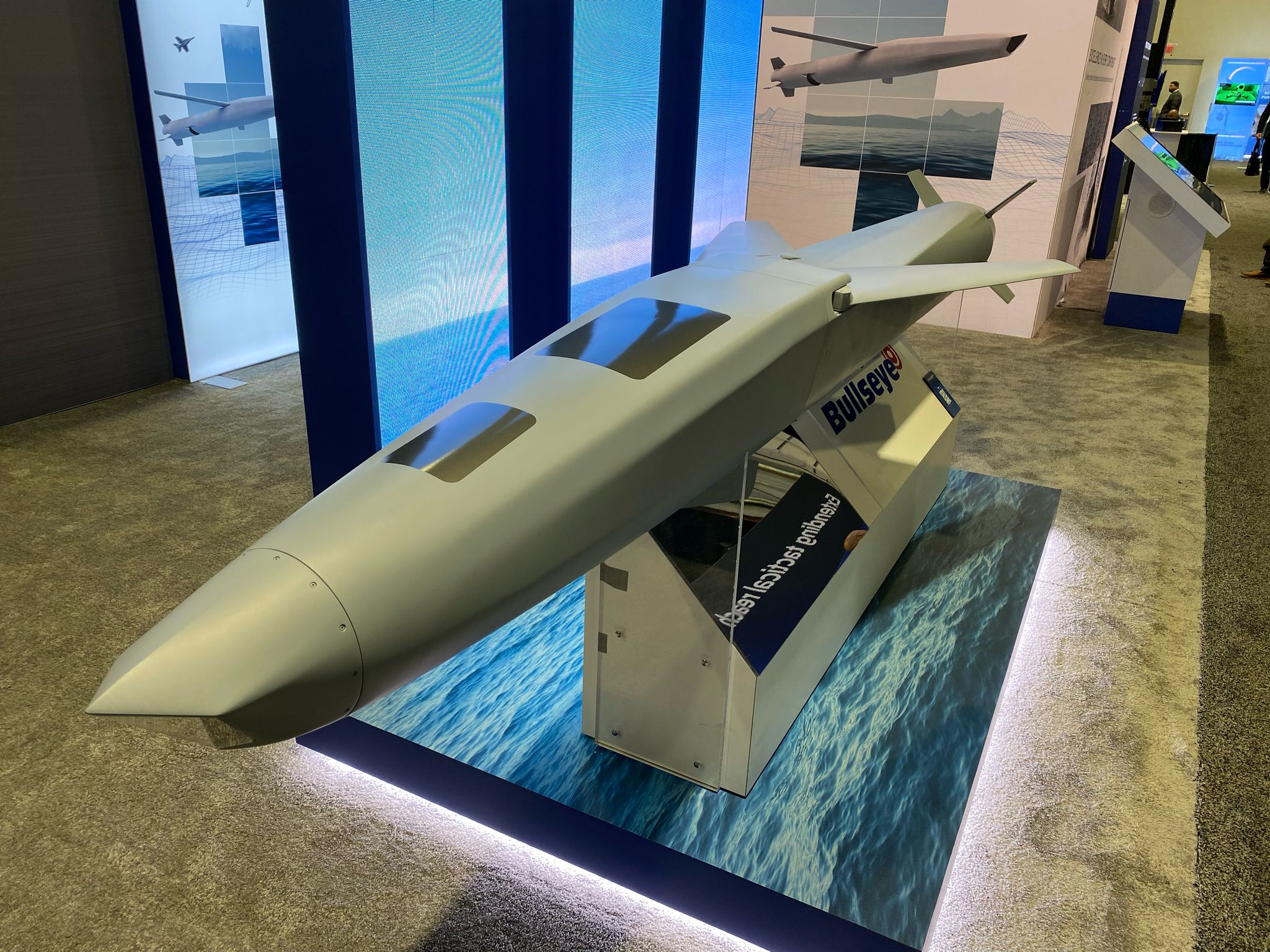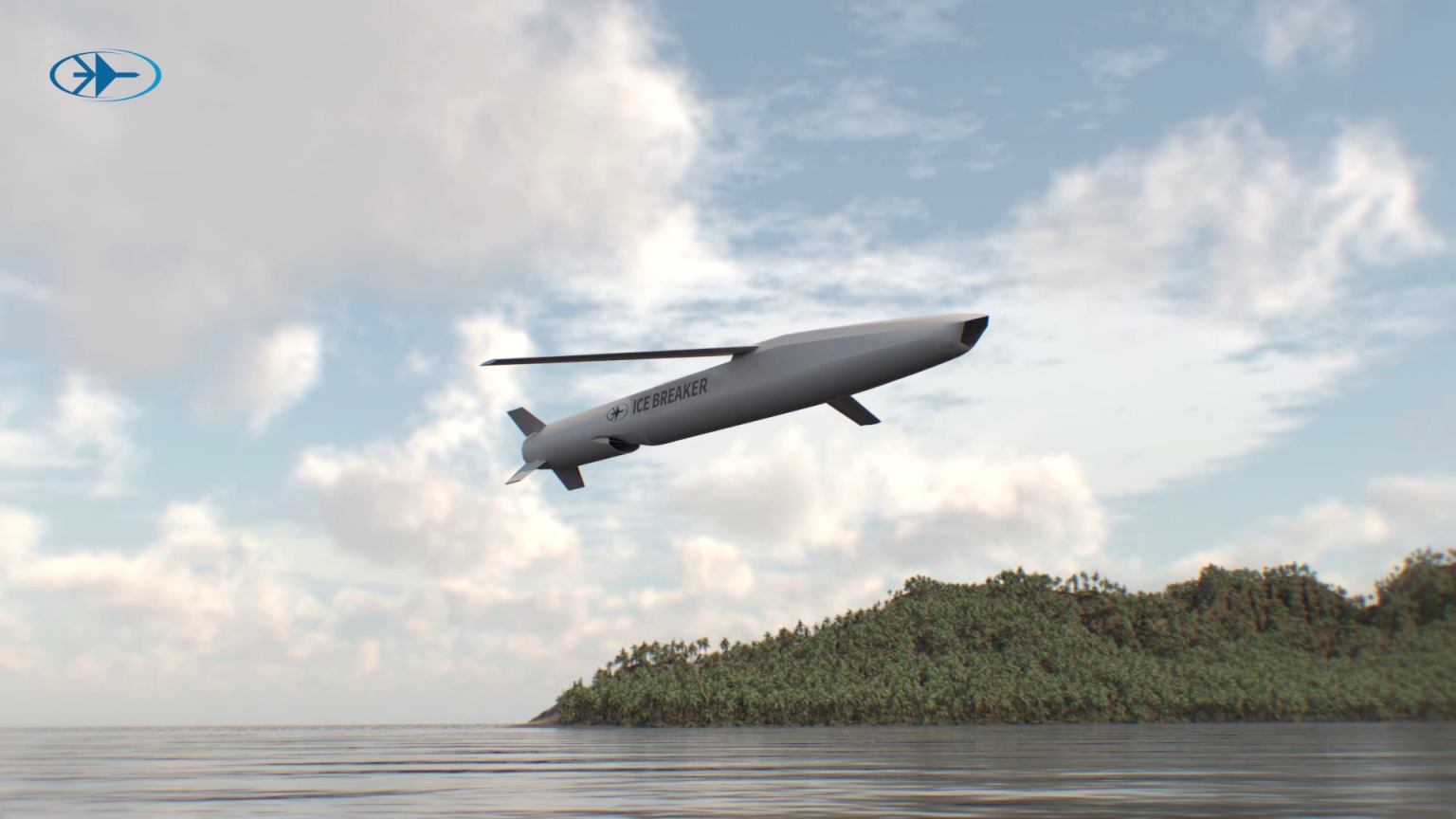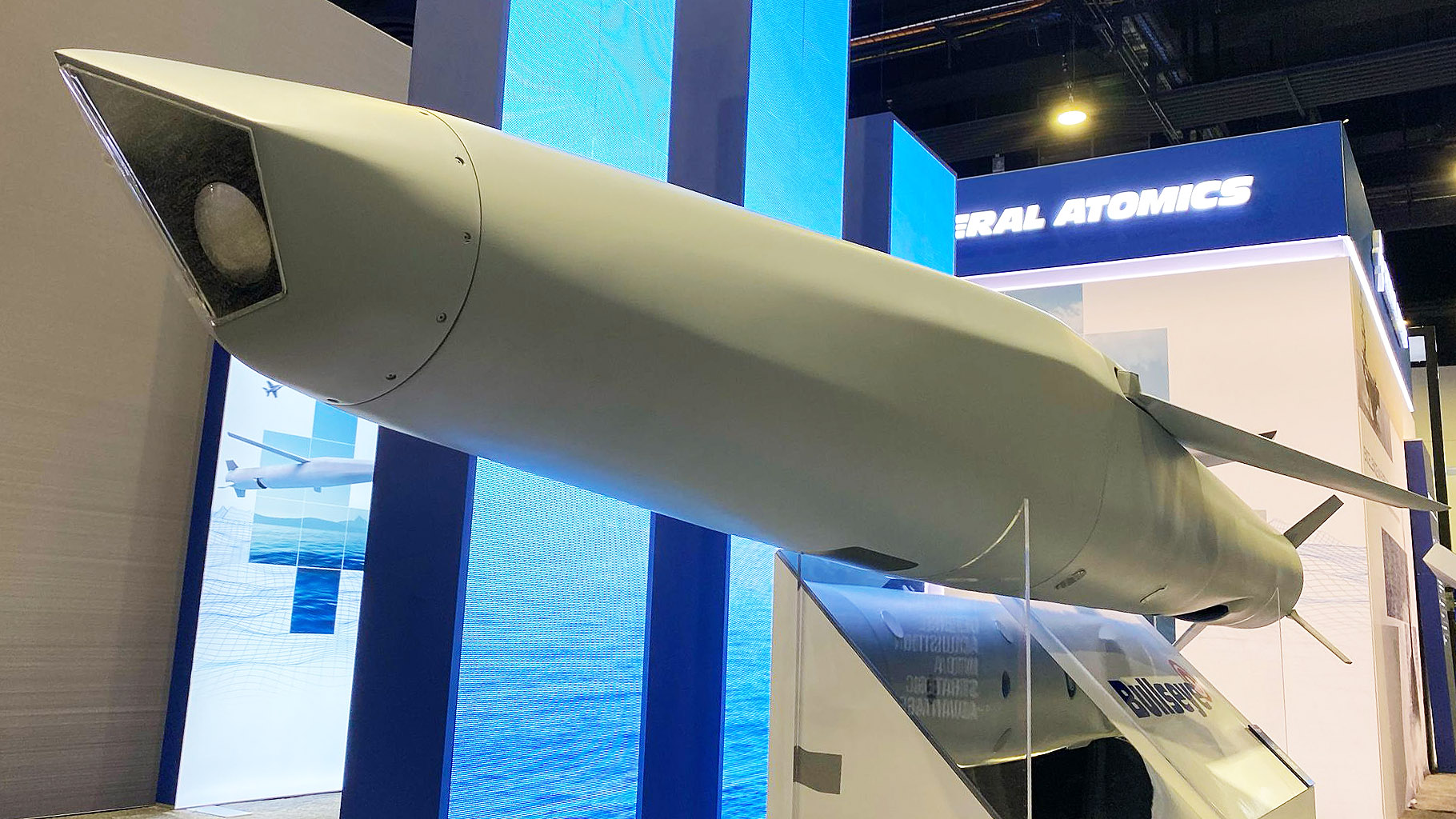General Atomics has officially unveiled the new Bullseye standoff precision-guided missile that it’s now working on alongside Israeli defense contractor Rafael. The new weapon leverages Rafael’s existing Ice Breaker missile and is being offered to the U.S. military and allies at a time when the Pentagon is increasingly focused on procuring affordable standoff weapons that can be rapidly produced en masse for future contingencies, especially in the Indo-Pacific theater. While a modular design able to be used or adapted for a variety of missions, General Atomics told TWZ it initially is aiming to sell the missile for maritime strike.
The U.S. firm displayed a full-size mockup of the Bullseye at the Sea-Air-Space Conference, now taking place at National Harbor, Maryland. TWZ has multiple staff on the ground at the event. General Atomics Electromagnetic Systems Group (GA-EMS) today also announced the signature of a Memorandum of Understanding (MoU) with Rafael Advanced Defense Systems, under which the American firm will be their partner and the U.S. prime contractor to manufacture the missile. General Atomics would build the missile at its site in Tupelo, Mississippi.

The Bullseye missile “will meet U.S. military specifications and will provide multi-platform launch capabilities from air, ground, and sea for strike mass at an affordable price point,” GA-EMS said in a media release today.
The prominent panels on the top of the Bullseye may well be associated with its satellite communications system, which sends data from the missile to the operator and allows it to be reprogrammed in flight. They could also be part of a system for providing navigation in GPS-denied environments and other challenging scenarios.
“We are excited to work with Rafael to introduce Bullseye, a highly effective deep-strike missile,” said Scott Forney, president of GA-EMS. “Bullseye will be built in the U.S. for delivery to U.S. military customers to support a variety of critical Department of Defense and coalition partners’ precision-fires missions.” Forney added: “By leveraging Rafael’s extensive investment in the design, maturation and testing of a unique, modular missile, we can reduce risk and development costs and provide production-scale delivery of a highly capable, high-performance precision-guided missile at significant per-unit cost-savings.”

“As a company that has spent decades pushing the boundaries of precision-strike technology, we are proud to partner with GA-EMS on the Bullseye program,” said Yuval Miller, executive vice president and head of Rafael’s Air & C4ISR Systems Division. “By combining Rafael’s combat-proven innovative fifth-generation missile technologies with GA-EMS’s advanced manufacturing, assembly, integration and test expertise, Bullseye will deliver unprecedented accuracy, flexibility and affordability, giving warfighters a state-of-the-art missile system that hits its mark and adapts to evolving mission needs.”
While today’s GA-EMS media release didn’t mention Rafael’s Ice Breaker, Forney confirmed to TWZ ahead of Sea-Air-Space, that the new missile is “leveraging the Ice Breaker program.”

In terms of potential sales, Forney said that he personally unveiled the Bullseye missile to U.S. Secretary of Defense Pete Hegseth last week and “we have been previewing it with some of our senior customers across the Pentagon.”
In terms of specifications, GA-EMS told TWZ that the Bullseye missile will have a length of just under four meters (13.1 feet) with a wingspan of just over two meters (6.6 feet) when deployed. This suggests that the dimensions are similar, if not identical, to the Rafael Ice Breaker. Depending on the payload, the Bullseye will weigh “under 1,000 pounds,” according to Forney, and will be able to strike targets at ranges “in excess of 300 kilometers” (186 miles). The missile is powered by a small jet engine and is considered to have low observable (LO) capabilities.
A Rafael promotional video showing the Ice Breaker:

As to the warhead, this will be available in two versions, weighing either 500 pounds or 250 pounds, both of them offering dual-use capabilities: combining the effects of a general-purpose high-explosive and a penetrating warhead.
Forney added that the company wants to compete with “something like the Joint Strike Missile” (JSM) in terms of range, but to offer a “significantly” lower cost. Produced by Kongsberg of Norway, the JSM appears very similar to the Bullseye, with the same overall length, stealthy features, and an imaging infrared seeker giving it very precise targeting capability that cannot be jammed using RF countermeasures while in the terminal phase of flight.

The Bullseye missile is a highly modular design and, while the initial sales opportunities are likely to be for the air-launched version, the weapons will also be suitable for launch from sea and ground platforms. Forney said that, while GA-EMS is “going hard for the air-launched opportunities,” the missile can also be canister-launched from a Mk 41 Vertical Launch System or an MLRS, for example.
At this point, Forney thinks there’s a particular demand in the United States for an air-launched missile that can be used against maritime targets, and he thinks the Bullseye would be “a perfect opportunity” for the U.S. Navy, bearing in mind that service’s current lack of anti-ship weapons in this class.
The maritime target set is also well suited to the missile’s baseline seeker technology, which is directly leveraged from the Ice Breaker. According to Rafael, the Ice Breaker “utilizes an advanced, all-weather, electro-optical imaging infrared (IIR) seeker,” which includes “scene-matching algorithms and Automatic Target Recognition (ATR).”
Rafael’s Miller told TWZ that the Israeli company considers the Bullseye to be a “fifth-generation missile,” in that it’s able to make its way to the target even in a GPS-denied environment throughout the entire flight, and also to survive against different types of threats. Its survivability will be aided by a sea-skimming flight profile for anti-ship strike missions, as well as being able to fly low around ground terrain.
TWZ was the first to report on the existence of what was then a still-unnamed air-to-surface missile in the works at General Atomics, back in January of this year, during the Surface Navy Association’s main annual symposium.

At that point, GA-EMS offered a rendering of the new weapon, then referred to simply as the “Strike Missile.” This was a notably slab-sided design with an air-breathing propulsion system and a single ventral intake. At that point, no other details were offered about the missile’s size, performance, or other specifications.
Presumably, the rendering was intended simply as a placeholder, since the mockup unveiled today appears to be almost identical to the Ice Breaker.
Leveraging this existing technology makes a lot of sense for GA-EMS, in terms of being able to get the weapon to market quickly.
This factor also recognizes the considerable and growing interest, especially within the U.S. military, in new air-launched strike munitions, particularly ones that are cheaper and easier to produce than existing designs.

The Bullseye is very clearly aimed at this market segment, with the U.S. military now deeply interested in acquiring new air-launched strike munitions that can be produced readily at scale, and economically, while also still offering useful standoff range. Fielding weapons in this class is increasingly seen as vital for providing sufficient strike capacity in future conflicts, especially high-end ones like a fight in the Pacific against China, and allowing for the relatively rapid replenishment of stockpiles. The war in Ukraine, in particular, has dramatically highlighted the need for extensive weapons stockpiles, especially in the case of long-range effects, and having the industrial capacity to rapidly ramp up production of such munitions when required.
One prime example of these kinds of efforts is the Enterprise Test Vehicle (ETV) project, run by the Air Force and the Pentagon’s Defense Innovation Unit (DIU), which is seen as being a potential stepping stone to new, lower-cost cruise missiles. General Atomics is not one of the four companies to have received an ETV contract — Anduril Industries, Integrated Solutions for Systems, Inc., Leidos subsidiary Dynetics, and Zone 5 Technologies are those that have.

With that in mind, it perhaps makes more sense that, at first, GA-EMS is looking to pitch its Bullseye most aggressively for potential U.S. Navy contracts. Should this be successful, it could open the door to many other unique and combat-proven weapons from Israeli manufacturers being brought to the U.S. market. Key examples would include the Delilah and Rampage standoff missiles, and the Rocks air-launched ballistic missile. The Spike anti-armor missile, notably, is already in the U.S. inventory.
At this stage, Rafael has already performed aerodynamics, engine, seeker, launch integration and testing, GA-EMS says, although it’s not entirely clear if this refers to the original Ice Breaker or the ‘Americanized’ Bullseye. Regardless, the U.S. firm says that further testing is now being scheduled “for flight qualification and to prove operational readiness.”
However, with missiles potentially ready for delivery starting in late 2025, should the U.S. military order the Bullseye, in whatever form, it could get its hands on operational examples of the missile sooner rather than later.
Contact the author: thomas@thewarzone.com
